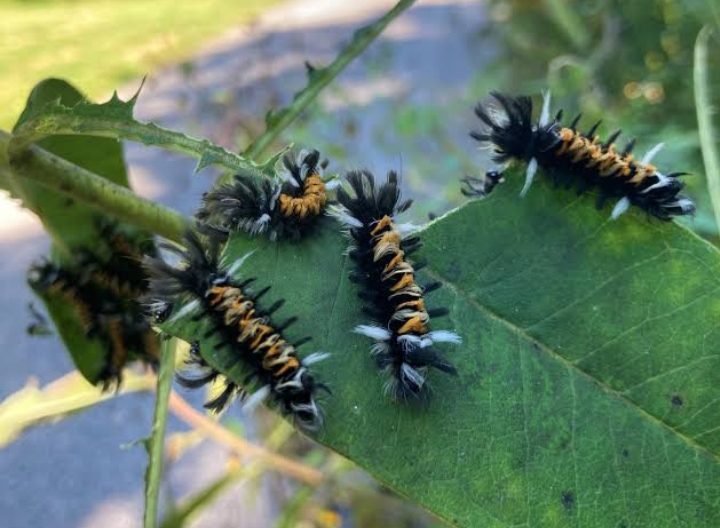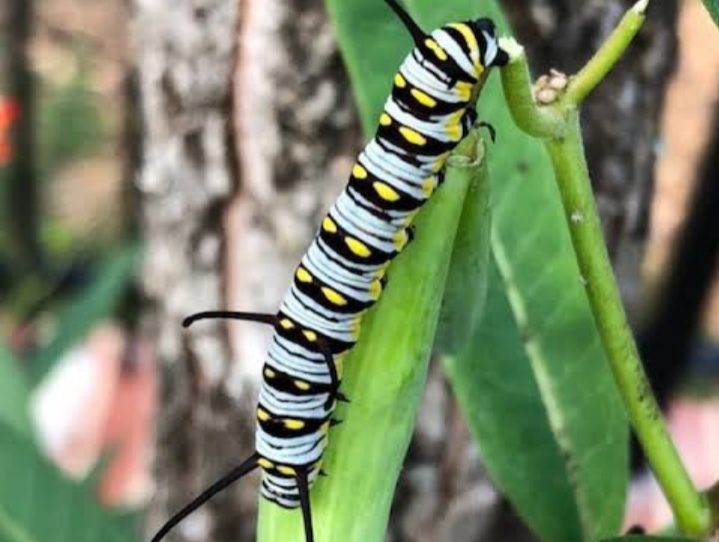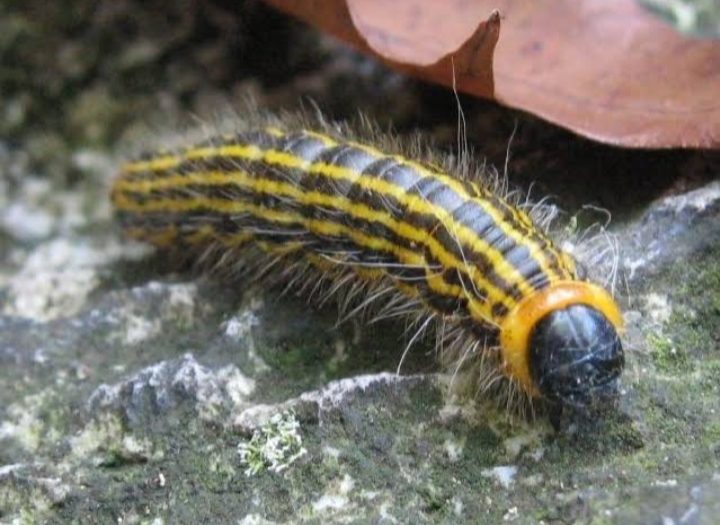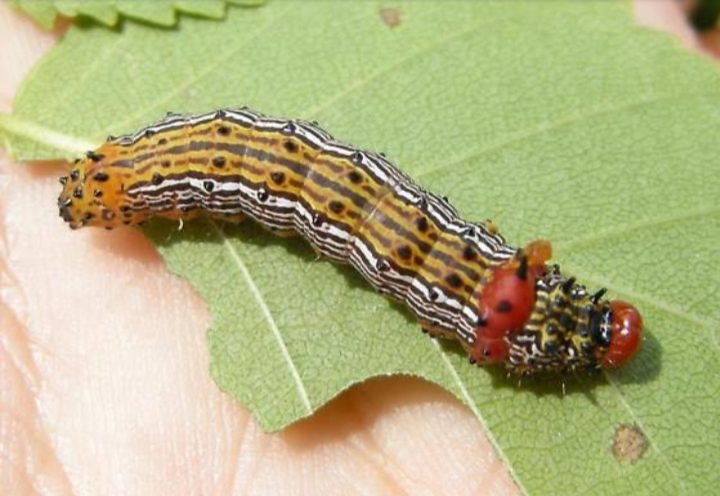A caterpillar is the larval stage of a moth or butterfly. It is the second part of their four-stage life cycle: egg, larva, pupa and adult. Caterpillars are typically voracious feeders and many of them are among the most serious of agricultural pests. Caterpillars of most species eat plant material (often leaves), but not all; some (about 1%) eat insects, and some are even cannibalistic.
caterpillars feed on a range of host plants, including vegetables and fruits, birch, cherry, apple, oak, and even some coniferous trees like fir and spruce, and may cause damage to trees when present in significant numbers.
Various species of caterpillar are also valued as sources of silk, as human or animal food, or for biological control of pest plants. Caterpillars come in various shapes, color-patterns and sizes. In this article get a comprehensive insight into different types of Yellow and Black caterpillars.
- Monarch caterpillar
- The white-marked tussock
- The yellow-spotted tussock
- Six-spot burnet caterpillar
- Queen butterfly caterpillar
- Catalpa caterpillar
- Giant sphinx caterpillar
- Zebra caterpillar
- Common sheep moth caterpillar
- Cinnabar moth caterpillar
- Brown-hooded owlet caterpillar
- Black swallowtail caterpillar
- Yellownecked caterpillar
- Mullein moth caterpillar
- Grapeleaf skeletonizer
- Redhumped moth caterpillar
- American dagger caterpillar
- Smeared dagger moth caterpillar
- Fall webworms
- White flannel moth caterpillar
Monarch caterpillar

The monarch butterfly is one of the most easily recognized butterfly. It is known by scientists as Danaus plexippus, which in Greek literally means “sleepy transformation.” The name evokes the species’ ability to hibernate and metamorphize.
Adult monarch butterflies possess two pairs of brilliant orange-red wings, featuring black veins and white spots along the edges. Males, who possess distinguishing black dots along the veins of their wings, are slightly bigger than females. Each adult butterfly lives only about four to five weeks.
Tussock Moth caterpillars

Tussock Moth caterpillars are known for their striking tufts of hair, or tussocks. Many species exhibit four characteristic clumps of bristles on their backs, giving them the appearance of a toothbrush. Some have longer pairs of tufts near the head and rear. Judged on looks alone, these fuzzy caterpillars might appear harmless but touch one with a bare finger and you’ll feel as if you’ve been pricked by fiberglass.
Tussock Moth adults are often dull brown or white. Females are usually flightless, and neither males nor females feed as adults. They focus on mating and laying eggs, after which they die within days.
Spotted tussock moth’s caterpillar

The spotted tussock moth’s caterpillar stage, commonly called the yellow wooly bear, is hairy with a yellow middle, and black with long white hair tufts at either end. Black spots usually run down the centre of the yellow middle section, however these spots may be orange instead. Some species may also have black spots marked against the orange or yellow body. The caterpillar gets to 4 cm long.
Though belonging to the tiger moth tribe, it is commonly called tussock because of the hair tufts appearing on the caterpillar’s back. Though not harmful or a pest to the environment, the larvae could result in allergic reactions when touched as they have urticating hairs.
Queen butterfly caterpillar

The queen butterfly caterpillar has visual similarity with the monarch and the black swallowtail caterpillars. They are patterned with alternating white and yellow stripes on a black base. There are also three pairs of needle-shaped protrusions from the head, on the back, and the last segment. The larvae have a small head and a large, spine- or hairless, cylindrical-shaped body. The stage lasts for 2 to 3 weeks.
When mature, the caterpillar is brown with purplish prolegs. The caterpillar lacks spines, and there is no hair on its body. Favorite habitats of the Queen are open and sunny, including fields, dunes, deserts, pastures, roadsides and along waterways.
Catalpa sphinx caterpillar

Catalpa sphinx caterpillar is one of the “hornworm” species, having a prominent black spine on the back end of the body. The caterpillar has a shiny black head and grow up to 3 inches long. Although body coloration and markings change as caterpillars grow, lengthwise yellow or green and black stripes become more apparent in larger caterpillars.
The caterpillar feed on leaves of apple, azalea, chickweed, elm, evening primrose, portulaca, purslane, Virginia creeper and many other plants. Catalpa caterpillars molt several times during development before they crawl down the tree trunk and pupate in the soil. Adults emerge several days later. There may be 4 to 5 generations per year.
Giant sphinx caterpillar

Giant sphinx caterpillar are velvety black with yellow rings and a reddish-orange head. They can attain lengths of up to 6 inches. The black ‘horn’ located on abdominal segment 8 is approximately one inch long and is located on an elevated orange ‘button’. Thoracic legs and prolegs are orange with black spots. Newly molted larvae are light yellow and dark gray in alternating transverse rings; several hours after molting, larvae become their typical yellow and black coloration.
Zebra caterpillar

The zebra caterpillar is the larva of an American noctuid moth that feeds on cabbages, beets and other cultivated plants. The caterpillar is generally 35 to 40 mm (1.4 to 1.6 in) long when mature. The newly hatched larvae are whitish, marked by dark heads and several dark spots scattered over the body. The more mature caterpillars vary in color, often displaying bright and conspicuous hues, usually with prominent black and light yellow longitudinal stripes.
The top stripe is black, the top-lateral stripe and the stripe below the spiracles are cream to bright yellow, and the spiracle stripe and bottom stripe are black and marked with numerous white lines and spots. The mid-dorsal line is pale and may be well developed or absent. The underside and legs are light red-brown or yellow. The head is reddish or reddish-brown and without dark arcs or reticulations.
Cinnabar moth caterpillar

The caterpillars of this species are also rather bold in colour, with black and yellow bands across the length of the body. The bright colours of both the larvae and the moths act as warning signs, so they are seldom eaten by predators. They can grow up to 30 mm (1.2 in), and are voracious eaters.
These caterpillars are commonly found on ragwort. Females can lay up to 300 eggs, usually in batches of 30 to 60 on the underside of ragwort leaves. Large populations can strip entire patches of ragwort clean.
They can also be found in well drained, open grassy habitats such as gardens, meadows, parks, mature sand-dunes, and heathland. When the caterpillars (larvae) hatch they feed on and around the area of the hatched eggs but as they get bigger and moult (instars) they mainly feed on the leaves and flowers of the plant, and can be seen out in the open during the day.
Brown-hooded owlet caterpillar

Brown-hooded owlet caterpillar is also called a Calico Paint caterpillar. It has a glossy black head with yellow lines and marks on it. A deep orange line centered between pinstripe yellow lines runs down the ‘back’. The sides of the caterpillar have short yellow and white lines, with a horizontal red line along the bottom by the legs. This larva feeds on aster and goldenrod.
The black swallowtail

The black swallowtail also called the eastern black swallowtail or American swallowtail and a variety of other colloquial names such as parsley worm is usually found in open areas, such as fields, meadows, parks, wetlands, prairies and sunny backyards.
Older caterpillars are green with transverse bands of black with yellow spots, a color pattern that likely makes them hard to see while resting on the sun-dappled host plants. The caterpillars eventually grow up to 1½ to 2 inches long. Once the caterpillar matures it wanders away from the host plants to find a place to pupate. It positions itself in the typical swallowtail “head-up” position on something such as a plant stem, tree trunk, foundation wall or other location and spins a slender silken band around the thoracic area to support itself.
Yellownecked caterpillar

The yellownecked caterpillar is a common pest of shade trees and shrubs. It feeds on a variety of trees including basswood, birch, elm, honeylocust, oak, maple, and walnut. This insect is also destructive on the foliage of blueberry, apple, and other fruit trees
The young yellownecked caterpillar is chestnut brown with obscure darker stripes. The fully grown larva is almost 2 inches (50 mm) long and has a bright yellow or orange band just behind the head. The body is distinctly striped black and yellow and is sparsely covered with long, whitish hairs. When disturbed, the caterpillar raises up both ends of its body, clinging to the plant with only its abdominal prolegs.
Mullein Moth caterpillars

Mullein Moth caterpillars are easy to spot on plants because of their vivid colours. The white caterpillars are covered in yellow and black markings. They chew the leaves and flowers, sometimes stripping plants when infestations are particularly bad. The caterpillars are active in the gardens from late May until mid-July and will molt four times before reaching the pupa stage of development.
Grapeleaf skeletonizer caterpillar

Grapeleaf skeletonizer caterpillars are stout, with ten bright yellow bands or lines of dots, and eleven black bands alternating. They have hair-like setae that, if brushed against, will give a rash that lasts several days. They feed in groups that become progressively smaller as the larvae age. They constantly live on the underside of the leaves, and frequently line up side by side. Development from hatch to pupation takes about 40 days.
Redhumped moth caterpillar

The full grown Redhumped moth caterpillar is about 1 to 1-1/2 inches (25 to 35 mm) long. The head is a dull red, along with the hump on the first abdominal segment (just after the thorax, the reason for its common name. The body is a yellowish color with black and white stripes. There are black tubercles on the top of several body segments. When at rest, the larva will often raise its posterior tip.
In the autumn, full-grown caterpillars move to the ground, spin a silk cocoon, and remain inside over the winter as inactive, mature larvae (prepupae). During spring, they undergo metamorphosis into pupae, then become adult moths that emerge and seek mates. The redhumped caterpillar has two or more generations per year.
American Dagger Moth Caterpillar

American Dagger Moth Caterpillar has a more remarkable appearance and size. Also about 50 mm (2 inches) long, it is completely covered in bright yellow/green bristles. Four long bunches of black bristles, like long eyelashes, extend from the body near the head and midsection. A fifth bunch of these extra-long, black bristles comes out near the rear of the caterpillar.
The caterpillar is most active from spring to early autumn and can be found in areas with deciduous trees like parks, backyards, forests and woodlands. Hairs on the American Dagger Moth Caterpillar can break off into skin and sting, causing hives, burning sensations, and general skin irritation, so handling this larva is not recommended.
Smeared dagger moth caterpillar

The smeared dagger moth caterpillar has a black body, covered in tufts of spines, white markings on its back, and a yellow wavy line along both of its sides. The caterpillars feed on a wide variety of deciduous trees including Oak, Hawthorn, Birch and Elm. The caterpillars are fully grown in 30-35 days.
Smeared dagger moth caterpillar also has stinging hair that causes severe pain, allergy, and swelling. The back of the caterpillar is adorned with bunches of thin, white bristles, reddish at the base.
Fall webworm caterpillar

Fall Webworms are caterpillars that weave loose webbing around the tree’s foliage whilst munching on leaves, resulting in plant stress and leaf loss. This larval “nest” may cover single leaves or leaf clusters, but more often the entire branch.
Fall webworm caterpillars are about an inch (2.5 cm.) long with black to reddish heads and light yellow to greenish bodies with a mottled stripe of two rows of black tubercles and tufts of long, whitish hairs.
These caterpillars may go through as many as eleven growth stages (instars) before leaving the web to pupate and multiple generations occur per year. The caterpillar feeds inside the tents until the late instars. Very young caterpillars feed only on the upper surfaces of leaves; later, they consume whole leaves.
White flannel moth caterpillar

The white flannel moth caterpillar has a black or reddish-black body and may also have white spots evenly spaced between the yellow bumps. The lower sides of the body, by the legs, are yellow. Both ends are red, adding the finishing touches to its alarming coloration. This stinging black and yellow caterpillar also has tufts of long feathery spines that can cause skin irritation. This caterpillar is often found on one of its host plants like redbud, elm, beech, hackberry, or black locust.